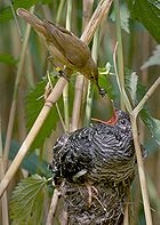
Brood parasite
Encyclopedia
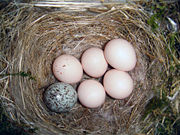
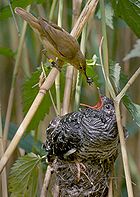
Kleptoparasitism
Kleptoparasitism or cleptoparasitism is a form of feeding in which one animal takes prey or other food from another that has caught, collected, or otherwise prepared the food, including stored food...
found among bird
Bird
Birds are feathered, winged, bipedal, endothermic , egg-laying, vertebrate animals. Around 10,000 living species and 188 families makes them the most speciose class of tetrapod vertebrates. They inhabit ecosystems across the globe, from the Arctic to the Antarctic. Extant birds range in size from...
s, fish
Fish
Fish are a paraphyletic group of organisms that consist of all gill-bearing aquatic vertebrate animals that lack limbs with digits. Included in this definition are the living hagfish, lampreys, and cartilaginous and bony fish, as well as various extinct related groups...
or insect
Insect
Insects are a class of living creatures within the arthropods that have a chitinous exoskeleton, a three-part body , three pairs of jointed legs, compound eyes, and two antennae...
s, involving the manipulation and use of host
Host (biology)
In biology, a host is an organism that harbors a parasite, or a mutual or commensal symbiont, typically providing nourishment and shelter. In botany, a host plant is one that supplies food resources and substrate for certain insects or other fauna...
individuals either of the same (intraspecific brood-parasitism) or different species (interspecific brood-parasitism) to raise the young of the brood-parasite. This relieves the parasitic parent from the investment of rearing young or building nest
Nest
A nest is a place of refuge to hold an animal's eggs or provide a place to live or raise offspring. They are usually made of some organic material such as twigs, grass, and leaves; or may simply be a depression in the ground, or a hole in a tree, rock or building...
s, enabling them to spend more time foraging, producing offspring
Offspring
In biology, offspring is the product of reproduction, of a new organism produced by one or more parents.Collective offspring may be known as a brood or progeny in a more general way...
etc. Additionally, the risk of egg loss to raiders such as raccoons is mitigated, by having distributed the eggs amongst a number of different nests. As this behaviour is damaging to the host, it will often result in an evolutionary arms race
Evolutionary arms race
In evolutionary biology, an evolutionary arms race is an evolutionary struggle between competing sets of co-evolving genes that develop adaptations and counter-adaptations against each other, resembling an arms race, which are also examples of positive feedback...
between parasite and host.
Avian brood parasites
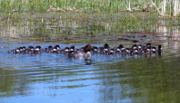
Parental investment
In evolutionary biology, parental investment is any parental expenditure that benefits one offspring at a cost to parents' ability to invest in other components of fitness...
in raising their offspring. This form of cuckoldry is taken a step further when females lay their eggs in the nests of other individuals. Intraspecific brood parasitism is seen in a number of duck
Duck
Duck is the common name for a large number of species in the Anatidae family of birds, which also includes swans and geese. The ducks are divided among several subfamilies in the Anatidae family; they do not represent a monophyletic group but a form taxon, since swans and geese are not considered...
species with females laying their eggs in the nests of others for example in the Goldeneye
Goldeneye (duck)
Goldeneye are small tree-hole nesting northern hemisphere seaducks belonging to the genus Bucephala. Their plumage is black and white, and they eat fish, crustaceans and other marine life....
, Bucephala clangula.
Interspecific brood-parasites include the Old World
Old World
The Old World consists of those parts of the world known to classical antiquity and the European Middle Ages. It is used in the context of, and contrast with, the "New World" ....
cuckoo
Cuckoo
The cuckoos are a family, Cuculidae, of near passerine birds. The order Cuculiformes, in addition to the cuckoos, also includes the turacos . Some zoologists and taxonomists have also included the unique Hoatzin in the Cuculiformes, but its taxonomy remains in dispute...
s in Eurasia
Eurasia
Eurasia is a continent or supercontinent comprising the traditional continents of Europe and Asia ; covering about 52,990,000 km2 or about 10.6% of the Earth's surface located primarily in the eastern and northern hemispheres...
and Australia
Australia
Australia , officially the Commonwealth of Australia, is a country in the Southern Hemisphere comprising the mainland of the Australian continent, the island of Tasmania, and numerous smaller islands in the Indian and Pacific Oceans. It is the world's sixth-largest country by total area...
, cowbirds and Black-headed Duck
Black-headed Duck
The Black-headed Duck is a South American duck allied to the stiff-tailed ducks in the subfamily Oxyurinae of the family Anatidae. It is the only member of the genus Heteronetta....
s in the Americas, and indigobird
Indigobird
The indigobirds and whydahs, are a family, Viduidae, of small passerine birds native to Africa.These are finch-like species which usually have black or indigo predominating in their plumage...
s, whydah
Whydah
Whydah may refer in English to:* The Viduidae birds, also called indigobirds* Ouidah, city and colonial fort in present Benin* Kingdom of Whydah, which included Ouidah but was headquartered in Savi...
s, and the honeyguide
Honeyguide
Honeyguides are near passerine bird species of the order Piciformes. They are also known as indicator birds, or honey birds, although the latter term is also used more narrowly to refer to species of the genus Prodotiscus. They have an Old World tropical distribution, with the greatest number of...
s in Africa
Africa
Africa is the world's second largest and second most populous continent, after Asia. At about 30.2 million km² including adjacent islands, it covers 6% of the Earth's total surface area and 20.4% of the total land area...
. Seven independent origins of obligate interspecific brood parasitism in birds have been proposed. While there is still some controversy over when and how many origins of interspecific brood parasitism have occurred, recent phylogenetic analyses suggest two origins in Passeriformes (once in New World cowbirds: Icteridae, and once in African Finches: Viduidae); three origins in Old World and New World cuckoos (once in Cuculinae, Phaenicophaeinae, and in Neomorphinae-Crotophaginae); a single origin in Old World honeyguides (Indicatoridae); and in a single species of waterfowl, the black-headed duck (Heteronetta atricapilla).
Most avian brood parasites are specialists which will only parasitize a single host species or a small group of closely related host species, but four out of the five parasitic cowbirds are generalists, which parasitize a wide variety of hosts; the Brown-headed Cowbird
Brown-headed Cowbird
The Brown-headed Cowbird is a small brood parasitic icterid of temperate to subtropical North America. They are permanent residents in the southern parts of their range; northern birds migrate to the southern United States and Mexico in winter, returning to their summer habitat around March or...
has 221 known hosts. They usually only lay one egg per nest, although in some cases, particularly the cowbird
Cowbird
Cowbirds are birds belonging to the genus Molothrus in the family Icteridae. They are brood parasitic New World birds which are unrelated to the Old World cuckoos, one of which, the Common Cuckoo, is the best-known brood parasitic bird....
s, several females may use the same host nest.
The Common Cuckoo
Common Cuckoo
The Common Cuckoo is a member of the cuckoo order of birds, Cuculiformes, which includes the roadrunners, the anis and the coucals....
presents an interesting case in which the species
Species
In biology, a species is one of the basic units of biological classification and a taxonomic rank. A species is often defined as a group of organisms capable of interbreeding and producing fertile offspring. While in many cases this definition is adequate, more precise or differing measures are...
as a whole parasitizes a wide variety of hosts, but individual females specialize in a single species. Gene
Gene
A gene is a molecular unit of heredity of a living organism. It is a name given to some stretches of DNA and RNA that code for a type of protein or for an RNA chain that has a function in the organism. Living beings depend on genes, as they specify all proteins and functional RNA chains...
s regulating egg coloration
Animal colouration
Animal coloration is the general appearance of an animal resulting from the reflection or emission of light from its surfaces. The mechanisms for colour production in animals include pigments, chromatophores, structural coloration, and bioluminescence....
appear to be passed down exclusively along the maternal line, allowing females to lay mimetic eggs in the nest of the species they specialize in. Females are thought to imprint
Imprinting (psychology)
Imprinting is the term used in psychology and ethology to describe any kind of phase-sensitive learning that is rapid and apparently independent of the consequences of behavior...
upon the host species which raised them, and subsequently only parasitize nests of that species. Male Common Cuckoos will fertilize females of all lines, maintaining sufficient gene flow
Gene flow
In population genetics, gene flow is the transfer of alleles of genes from one population to another.Migration into or out of a population may be responsible for a marked change in allele frequencies...
among the different maternal lines.
The mechanisms of host selection by female cuckoos are somewhat unclear, though several hypotheses have been suggested in attempt to explain the choice. These include genetic inheritance of host preference, host imprinting on young birds, returning to place of birth and subsequently choosing a host randomly ("natal philopatry"), choice based on preferred nest site (nest-site hypothesis), and choice based on preferred habitat
Habitat
* Habitat , a place where a species lives and grows*Human habitat, a place where humans live, work or play** Space habitat, a space station intended as a permanent settlement...
(habitat-selection hypothesis
Habitat-selection hypothesis
Habitat selection hypothesis in an attempt to explain the mechanisms of brood parasite nest selection in cuckoos. In habitat selection hypothesis, a female cuckoo retains recognition of the habitat type in which she was reared, and will subsequently return to this habitat type in order to lay...
). Of these hypotheses the nest-site selection and habitat selection have been most supported by experimental analysis.
Common adaptations of avian brood parasites
Among specialist avian brood parasites, mimetic eggs are a nearly universal adaptationAdaptation
An adaptation in biology is a trait with a current functional role in the life history of an organism that is maintained and evolved by means of natural selection. An adaptation refers to both the current state of being adapted and to the dynamic evolutionary process that leads to the adaptation....
. There is even some evidence that the generalist Brown-headed Cowbird may have evolved an egg coloration mimic
Mimic
In evolutionary biology, mimicry is the similarity of one species to another which protects one or both. This similarity can be in appearance, behaviour, sound, scent and even location, with the mimics found in similar places to their models....
king a number of their hosts.
Most avian brood parasites will remove a host egg when they lay one of their own in a nest. Depending upon the species, this can happen either in the same visit to the host nest or in a separate visit before or after the parasitism. This both prevents the host species from realizing their nest has been parasitized and reduces competition
Competition (biology)
Competition is an interaction between organisms or species, in which the fitness of one is lowered by the presence of another. Limited supply of at least one resource used by both is required. Competition both within and between species is an important topic in ecology, especially community ecology...
for the parasitic nestling once it hatches.
_e_(_zonotrichia_capensis_).jpg)
Avian incubation
Incubation refers to the process by which certain oviparous animals hatch their eggs, and to the development of the embryo within the egg. The most vital factor of incubation is the constant temperature required for its development over a specific period. Especially in domestic fowl, the act of...
periods and rapid nestling growth. This gives the parasitic nestling a head start on growth over its nestmates, allowing it to outcompete them. In cases where the host nestlings are significantly smaller than the parasite nestling, the host nestlings will often starve
Starvation
Starvation is a severe deficiency in caloric energy, nutrient and vitamin intake. It is the most extreme form of malnutrition. In humans, prolonged starvation can cause permanent organ damage and eventually, death...
to death. Some brood parasites will eliminate all their nestmates shortly after hatching, either by ejecting them from the nest or killing them with sharp mandible
Mandible
The mandible pronunciation or inferior maxillary bone forms the lower jaw and holds the lower teeth in place...
hooks which fall off after a few days.
"Mafia hypothesis"
It has often been a question why the majority of the hosts of brood parasites care for the nestlings of their parasites. Not only do these brood parasites usually differ significantly in size and appearance, but it is highly probable that they reduce the reproductive successReproductive success
Reproductive success is defined as the passing of genes onto the next generation in a way that they too can pass those genes on. In practice, this is often a tally of the number of offspring produced by an individual. A more correct definition, which incorporates inclusive fitness, is the...
of their hosts. So what possible benefits are gained from providing this parental care? Through studies in an attempt to answer this question evolved the "Mafia hypothesis". This hypothesis revolves around host manipulations induced by behaviors of the brood parasite. Upon the detection and rejection of a brood parasite's egg, the host's nest is depredated upon, its nest destroyed and nestlings injured or killed. This threatening response is indirectly enhancing selective pressures favoring aggressive
Aggressive
“Aggressive” is a New York-based Grammy award-winning music video and commercial directing team of Alex Topaller and Daniel Shapiro.Aggressive has been described by Movie Creation Mag as “having a fascination with the wonderful, in the likes of the surrealist Rafal Olbinski” and “tenacious about...
parasite behavior that may result in positive feedback
Positive feedback
Positive feedback is a process in which the effects of a small disturbance on a system include an increase in the magnitude of the perturbation. That is, A produces more of B which in turn produces more of A. In contrast, a system that responds to a perturbation in a way that reduces its effect is...
between Mafia-like parasite and compliant host behaviors.
There are two avian species that have been speculated to portray this mafia
Mafia
The Mafia is a criminal syndicate that emerged in the mid-nineteenth century in Sicily, Italy. It is a loose association of criminal groups that share a common organizational structure and code of conduct, and whose common enterprise is protection racketeering...
-like behavior, the brown-headed cowbird of North America, Molothrus ater, and the Great Spotted Cuckoo
Great Spotted Cuckoo
The Great Spotted Cuckoo is a member of the cuckoo order of birds, the Cuculiformes, which also includes the roadrunners, the anis and the coucals....
of Europe, Clamator glandarius. The Great Spotted Cuckoo lays the majority of its eggs in the nests of the European Magpie
European Magpie
The European Magpie, Eurasian Magpie, or Common Magpie, , is a resident breeding bird throughout Europe, much of Asia and northwest Africa. It is one of several birds in the crow family named as magpies, and belongs to the Holarctic radiation of "monochrome" magpies...
, Pica pica. It has been observed that the Great Spotted Cuckoo repeatedly visits the nests that it has parasitised, a precondition for the Mafia hypothesis. An experiment was run by Soler et al. from April to July, 1990–1992 in the high-altitude plateau Hoya de Guadix, Spain. They observed the effects of the removal of cuckoo eggs on the reproductive success of the magpie, and measured the magpie's reaction; the egg was considered accepted if it remained in the nest, ejected if gone in between visits, or abandoned if the eggs were present but cold. If any nest contents were gone between consecutive visits, the nests were considered to have been depredated. The magpie's reproductive success was measured by number of nestlings that survived to their last visit, which was just before the nestling had been predicted to fledge
Fledge
Fledge is the stage in a young bird's life when the feathers and wing muscles are sufficiently developed for flight. It also describes the act of a chick's parents raising it to a fully grown state...
from the nest. The results from these experiments show that after the removal of the parasitic eggs from the Great Spotted Cuckoo, these nests are predated at much higher rates than those where the eggs were not removed. Through the use of plasticine
Plasticine
Plasticine, a brand of modelling clay, is a putty-like modelling material made from calcium salts, petroleum jelly and aliphatic acids. The name is a registered trademark of Flair Leisure Products plc...
eggs that model those of the magpie, it was confirmed that the nest destruction was caused by the Great Spotted Cuckoo. This destruction benefits the cuckoo, for the possibility of re-nesting by the Magpie allows another chance for the cuckoo egg to be accepted.
Another similar experiment was done in 1996–2002 by Hoover et al. on the relationship between the parasitic Brown-headed Cowbird and a host, the Prothonotary Warbler
Prothonotary Warbler
The Prothonotary Warbler is a small songbird of the New World warbler family. It is the only member of the genus Protonotaria....
, Protonotaria citrea. In their experiment, they manipulated the cowbird egg removal and cowbird access to the predator proof nests of the warbler. They found that 56% of egg ejected nests were depredated upon in comparison to 6% of non-ejected nests when cowbirds were not prevented from getting to the hosts' nest. Of the nests that were rebuilt by hosts that had previously been predated upon, 85% of those were destroyed. The number of young produced by the hosts that ejected eggs dropped 60% compared to those that accepted the cowbird eggs.
Nest-site hypothesis
In this hypothesis, female cuckooCuckoo
The cuckoos are a family, Cuculidae, of near passerine birds. The order Cuculiformes, in addition to the cuckoos, also includes the turacos . Some zoologists and taxonomists have also included the unique Hoatzin in the Cuculiformes, but its taxonomy remains in dispute...
s select a group of host species with similar nest sites and egg characteristics to her own. This population of potential hosts is monitored and a nest is chosen from within this group.
Research of nest collections has illustrated a significant level of similarity between cuckoo eggs and typical eggs of the host species. A low percentage of parasitized nests were shown to contain cuckoo eggs not corresponding to the specific host egg morph. In these mismatched nests a high percent of the cuckoo eggs were shown to correlate to the egg morph of another host species with similar nesting sites. This has been pointed to as evidence for nest- site selection.
A criticism of the hypothesis is that it provides no mechanism by which nests are chosen, or which cues might be used to recognize such a site.
Host responses
Given the detrimental effects avian brood parasites can have on their hosts' reproductive success, host species have come up with various defenses against this unique threat.Given that the cost of egg removal concurrent with parasitism is unrecoverable, the best defense for hosts is avoiding parasitism in the first place. This can take several forms, including selecting nest sites which are difficult to parasitize, starting incubation early so they are sitting on the nests when parasites visit them early in the morning, and aggressive territorial defense. Birds nesting in aggregations can also benefit from group defense.
Once parasitism has occurred, the next most optimal defense is to eject the parasitic egg. Recognition of parasitic eggs is based on identifying pattern differences or changes in the number of eggs. This can be done by grasp ejection if the host has a large enough beak
Beak
The beak, bill or rostrum is an external anatomical structure of birds which is used for eating and for grooming, manipulating objects, killing prey, fighting, probing for food, courtship and feeding young...
, or otherwise by puncture ejection. Ejection behavior has some costs however, especially when host species have to deal with mimetic eggs. In that case, hosts will inevitably mistake one of their own eggs for a parasite egg on occasion and eject it. In any case, hosts will sometimes damage their own eggs while trying to eject a parasite egg.
Among hosts not exhibiting parasitic egg ejection, some will abandon parasitized nests and start over again. However, at high enough parasitism frequencies, this becomes maladaptive as the new nest will most likely become reparasitized.
Other behavior can include modifying the nest to exclude the parasitic egg, either by weaving over the egg or in some cases rebuilding a new nest over the existing one.
Insect brood parasites
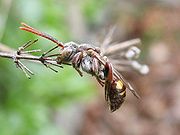
Cuckoo bee
The term cuckoo bee is used for a variety of different bee lineages which have evolved the kleptoparasitic habit of laying their eggs in the nests of other bees, reminiscent of the behavior of cuckoo birds. The name is technically best applied to the apid subfamily Nomadinae...
s, all of which are brood-parasitic insects, laying their eggs in the nest cells of other bees, but they are normally referred to as kleptoparasites, rather than as brood parasites. A family of Cuckoo wasp
Cuckoo wasp
Commonly known as cuckoo wasps, the Hymenopteran family Chrysididae is a very large cosmopolitan group of parasitoid or cleptoparasitic wasps, often highly sculptured, with brilliantly colored metallic-like bodies...
s also exist, many of which lay their eggs in the nests of Potter
Potter wasp
Potter wasps are a cosmopolitan wasp group presently treated as a subfamily of Vespidae, but sometimes recognized in the past as a separate family, Eumenidae.-Recognition:...
and Mud dauber
Mud dauber
Mud dauber is a name commonly applied to a number of wasps from either the family Sphecidae or Crabronidae that build their nests from mud...
wasps, and many other lineages of wasp
Wasp
The term wasp is typically defined as any insect of the order Hymenoptera and suborder Apocrita that is neither a bee nor an ant. Almost every pest insect species has at least one wasp species that preys upon it or parasitizes it, making wasps critically important in natural control of their...
s in various families have evolved similar habits.
External links
Includes links to host lists for all known brood-parasitic bird species.- Parasitism Research - Parasitism articles and links.

